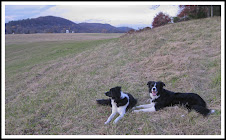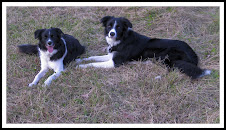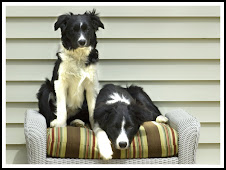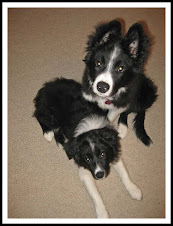We survived our first Puppy Kindergarten class with our two wild and crazy puppies! There were at least 10 other puppies there, all in the 10 to 16 week age group. Three chocolate labs, 2 standard poodles, 2 labradoodles, a vishla, .... and at least two humans for each puppy. There was also an adult dog, Maddie, the trainer’s ‘assistant’ and model for good behaviour. It was a room full of fun and puppiness.
Even before getting to the class, though, it was a real challenge to get the two of them into the crate in the back of the van. We didn’t realize that they were so afraid of it. They have not been in the van since we drove home to Connecticut from Burlington, Ontario, Canada, (where our families are and where we have a second home) shortly after Christmas. The all-day drive was probably more traumatic for them than we were aware. In the end, we managed to get Emma inside the crate, and I held Will in my arms to do the half-mile drive to the class. We realize that this means that car rides will now be added to our training agenda. They really need to be comfortable in a vehicle since we plan lots of short trips for hiking, training and visiting, as well as long trips to our second home.
The class began with puppy playtime. Will and Emma were happy to meet other puppies, and we were glad to see that they played with their new friends rather than each other. They were excited but did not play as aggressively with the new pups as they do with each other, which was a relief to see. After a few minutes of this playtime, we all sat in a circle to listen and watch the demonstrations. This might sound easy, but this was the biggest challenge of the whole evening! After a few minutes sitting side by side, I moved away from Jim and Emma to see if they would sit quietly to listen. Then began the second challenge, when all Will wanted to do was bark at the pups close by. Karen, the trainer, suggested using food to distract him, so I did this and it seemed to work somewhat. It was still a constant challenge and he eventually lost interest in the food. Thank goodness it was finally time to try some of the things she’d been demonstrating.
Karen used pups from the group to demonstrate the tasks for the evening. First,she showed how to teach the pups their name. It’s a simple process. You say the pup’s name, then when he looks at you in the eye, exclaim "yes" or "good boy" and reward immediately with a small tasty treat. It may take a few times to get him to look the first time, but then it is pretty reliable. I worked with Will to do this, and it took a few times to get his attention away from another pup, but I finally knew he had learned his name when he whipped his head around each time I said his name. More practice at home will help reinforce this.
The next thing we did was to learn how to teach sit and down with verbal commands as well as hand signals. Our puppies both know how to sit by verbal command, and to lie down with a treat, so this was something that we were anxious to learn more about. Again, using small treats as a reward, say sit and raise your hand straight up in front of them to get the pup to sit. This was easy. To get the pup to lie down, say down while moving your hand straight down in front of them. It was easier to do when I was down low to the ground, but I tried it with Will while standing up. This needs lots more practice.
There was also a guest speaker, a local veterinarian, who spoke about crate training for housetraining and to prevent destruction of the house even as they get older, what to use as treats to avoid weight problems and also how to teach the pups to be used to being handled by the vet or groomer. He recommended to hold the pup’s paws one at a time, spreading the toes in your fingers and handling each toe individually. This prepares them for grooming and also clipping their claws, which is something that each owner should be able to handle. Also, he showed how to open the mouth and rub the teeth so they are accustomed to getting their teeth brushed and checked at the vet. These things should be done daily until they are calm with it.
The class ended with more playtime. This time, Will and Emma seemed happy to watch what the other pups were doing, rather than getting really involved in playing. We tried to engage them in some of the play equipment. By throwing a ball through the long tunnel used in agility, I got Will to run through it a few times. He even walked up a long ramp, but was helped down carefully. Emma, who at home is the one that likes to explore small places, didn’t seem interested in the tunnel but really liked meeting new people. The puppies slowly filtered out with their owners, leaving the room much quieter than when we arrived. We have lots of homework to do before next week. On the top of the list: Take each puppy for a car ride!
Even before getting to the class, though, it was a real challenge to get the two of them into the crate in the back of the van. We didn’t realize that they were so afraid of it. They have not been in the van since we drove home to Connecticut from Burlington, Ontario, Canada, (where our families are and where we have a second home) shortly after Christmas. The all-day drive was probably more traumatic for them than we were aware. In the end, we managed to get Emma inside the crate, and I held Will in my arms to do the half-mile drive to the class. We realize that this means that car rides will now be added to our training agenda. They really need to be comfortable in a vehicle since we plan lots of short trips for hiking, training and visiting, as well as long trips to our second home.
The class began with puppy playtime. Will and Emma were happy to meet other puppies, and we were glad to see that they played with their new friends rather than each other. They were excited but did not play as aggressively with the new pups as they do with each other, which was a relief to see. After a few minutes of this playtime, we all sat in a circle to listen and watch the demonstrations. This might sound easy, but this was the biggest challenge of the whole evening! After a few minutes sitting side by side, I moved away from Jim and Emma to see if they would sit quietly to listen. Then began the second challenge, when all Will wanted to do was bark at the pups close by. Karen, the trainer, suggested using food to distract him, so I did this and it seemed to work somewhat. It was still a constant challenge and he eventually lost interest in the food. Thank goodness it was finally time to try some of the things she’d been demonstrating.
Karen used pups from the group to demonstrate the tasks for the evening. First,she showed how to teach the pups their name. It’s a simple process. You say the pup’s name, then when he looks at you in the eye, exclaim "yes" or "good boy" and reward immediately with a small tasty treat. It may take a few times to get him to look the first time, but then it is pretty reliable. I worked with Will to do this, and it took a few times to get his attention away from another pup, but I finally knew he had learned his name when he whipped his head around each time I said his name. More practice at home will help reinforce this.
The next thing we did was to learn how to teach sit and down with verbal commands as well as hand signals. Our puppies both know how to sit by verbal command, and to lie down with a treat, so this was something that we were anxious to learn more about. Again, using small treats as a reward, say sit and raise your hand straight up in front of them to get the pup to sit. This was easy. To get the pup to lie down, say down while moving your hand straight down in front of them. It was easier to do when I was down low to the ground, but I tried it with Will while standing up. This needs lots more practice.
There was also a guest speaker, a local veterinarian, who spoke about crate training for housetraining and to prevent destruction of the house even as they get older, what to use as treats to avoid weight problems and also how to teach the pups to be used to being handled by the vet or groomer. He recommended to hold the pup’s paws one at a time, spreading the toes in your fingers and handling each toe individually. This prepares them for grooming and also clipping their claws, which is something that each owner should be able to handle. Also, he showed how to open the mouth and rub the teeth so they are accustomed to getting their teeth brushed and checked at the vet. These things should be done daily until they are calm with it.
The class ended with more playtime. This time, Will and Emma seemed happy to watch what the other pups were doing, rather than getting really involved in playing. We tried to engage them in some of the play equipment. By throwing a ball through the long tunnel used in agility, I got Will to run through it a few times. He even walked up a long ramp, but was helped down carefully. Emma, who at home is the one that likes to explore small places, didn’t seem interested in the tunnel but really liked meeting new people. The puppies slowly filtered out with their owners, leaving the room much quieter than when we arrived. We have lots of homework to do before next week. On the top of the list: Take each puppy for a car ride!










No comments:
Post a Comment